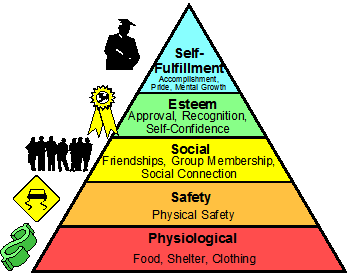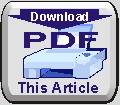|
Abraham Maslow's "Hierarchy of Needs" is a simple, effective and practical way to understand
normal human behavior. It is a management classic that many of us vaguely recall it from some
long-ago study. This article summarizes the original 1943 paper, "A
Theory of Human Motivation."
The Five Basic Needs
Maslow suggested five categories of basic needs that are common to all human beings. These
categories apply across all cultures, activities, professions and social positions. They are:
Physiological Needs
The physiological needs are those things that keep the body alive and reasonably healthy.
Examples are food, clothing and shelter. This is the most basic need of any organism and is at
the bottom of the hierarchy as shown in the figure.
Safety
People need to feel physically safe in their environment. In millennia past this meant safe
from prowling saber tooth tigers. Today it may mean safety from assault or safety from harmful
equipment and harmful chemicals.
Social Needs
Maslow originally used the term "Love Needs" but his description better fits the word
"Social". This need involves connections with other people and includes family, group
belongingness and friendship as well as romance. All normal people want a place in a group or
society, even if they sometimes deny it.
Esteem Needs
With a few pathological exceptions, people need a realistic sense of self esteem and esteem
from others. Self Esteem includes honest achievement, feeling adequate to face the world,
confidence , independence and freedom. Esteem from others involves reputation, respect,
attention and recognition.
Self Fulfillment (Self-Actualization) Needs
Self-Actualization is the most misunderstood of Maslow's categories because of its
unfortunate word choice. The ancient Greeks would have called it "fulfilling your destiny."
Maslow explains it further at right.
The Hierarchy
The needs are not equal in their motivational power at any given time. They have a hierarchy
of "prepotency." This means that lower needs in the hierarchy must be substantially gratified
before higher needs become motivators. People who are malnourished, hungry and cold are hardly
interested in approval or recognition--they just want food and warmth and they will take serious
personal risks to obtain it.
Once the physiological needs are substantially satisfied, people are concerned about safety.
They need to feel freedom from violence, accidents or other physical harm. Without this feeling,
they have little concern for friendship, recognition or destiny.
When people feel reasonably safe and have the physiological means to sustain life, social
needs come into play and so on until self-fulfillment becomes the prime mover for behavior.
The Role of Fear
In the eighth of Edwards Deming's Fourteen Points,
he urged managers to "Drive fear out of the workplace" for a very practical reason:
Fear only motivates to minimal compliance.
Once minimal compliance with demands are met, the fear is removed and motivation ceases. Fear
does not get the best performance from people. It often brings out unintended and undesirable
behaviors.
Physiological and safety needs are largely met in modern societies. Their power to directly
motivate mostly ended with labor unions, the welfare state and the liberation of Auschwitz. To
some extent, irrational fear can still motivate. For example, fear of losing a job stems from
irrational fears of ensuing starvation. such fears, however, are secondary.
The lower needs (physiological and safety) motivate entirely through fear. For some people
and to some extent, social and esteem needs are fear-based. Therefore, these lower needs are
incompatible with Lean and with high performance. Besides, they never did work very well.
What About Lean?
Effective Lean operations leverage these higher motivators and integrate them with
appropriate technologies. The concepts of
Socio-Technical Systems play a large role in this.
More....
|
|
 
 Abraham
Maslow (1908-1970) Abraham
Maslow (1908-1970)
A psychologist, Maslow studied what he
called exemplary peoples rather than the mentally ill or neurotic. He wrote that "the
study of crippled, stunted, immature, and unhealthy specimens can yield only a cripple
psychology and a cripple philosophy." Maslow was among the first "humanist
psychologists" who focused on normal, healthy ways of coping with life.
Maslow first published his theory in the
1943 and it became a widely accepted notion in the fields of psychology and
anthropology. This original article,
A Theory of Human
Motivation , is available on the internet. He was a professor at Brandeis
University. His major texts included Motivation and Personality (1954) and
Toward a Psychology of Being (1962).
 
|

Abraham Maslow's Hierarchy of Needs
|
 
Maslow on Self-Actualization
"A musician must make music, an artist must paint, a poet must write if he is to be
ultimately happy. What a man can be, he must be."
or
"Growth is, in itself,
a rewarding and exciting process, e.g., the fulfilling of yearnings and ambitions, like
that of being a good doctor; the acquisition of admired skills, like playing the violin
or being a good carpenter; the steady increase of understanding about people or about
the universe, or about oneself; the development of creativeness in whatever field, or,
most important, simply the ambition to be a good human being."
 
|
Authors: Quarterman Lee in collaboration with August Tetzlaff, JAN
2010 |






